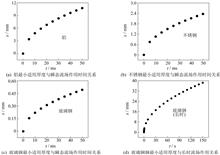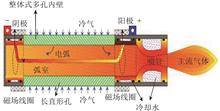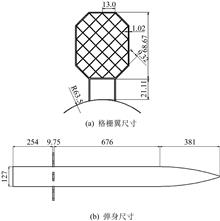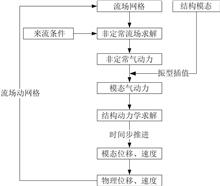 View fulltext
View fulltext
The phosphor thermography technology is one of the key technologies to measure the thermal environment of aircraft model surface in the flow fields of hypersonic wind tunnels.However,there is still a lack of systematic research on the heat transfer characteristics of film-based structures with temperature sensitive paint (TSP) and the applicability of film-based materials.Therefore,a numerical simulation analysis on the internal heat transfer characteristics of TSP film-based structures with different material thicknesses under different flow field conditions is carried out.The effects of therunning time,surface heatflux,and TSP layer thickness on the internal thermal diffusion depth and surface temperature rise of the film-based structures with different material systems are studied for hypersonicshock and blow-down wind tunnels.The results show that the internal thermal diffusion depth of the TSP film-based structure is mainly related to the thermal diffusion coefficient of the model material and the running time,and is less affected by the heatflux and the TSP layer thickness.The surface temperature rise mainly varies with the heatfluxand TSP layer thickness,and the changes both are positively correlated.The research results could provide theoretical support for the customized design of the material and thickness of film-based structures in the applications of phosphor thermography in wind tunnel tests.
Directionally solidified porous materials could be used to replace the water-cooled cooper walls in arc heaters,by which the enthalpy of the gas flow and the heat efficiency could be improved,and thus has a wide application prospect.In this paper,a mathematical model is developed for the heat transfer in unidirectional porous materials contacted with electric arcs.Numerical simulations are carried out to study the effects of porosity,aperture diameter,entry angle,and injection rate on the cooling performance of directional porous materials.The results indicate that the heat flux of the inner wall decreases by 92% with the increase in the porosity from 7.9% to 26.7%.When the porosity and flow velocity are constant,the average temperature of the inner wall increases from 498 K to 697 K with the increase in the aperture diameter from 0.3 mm to 0.8 mm.The variation of the entry angle could affect the injection rate and heat flux of the inner wall,and then change the cooling performance of the directional porous material.In addition,the increase in the injection rate from 14.2% to 42.7% could decrease the heat flux of the inner wall by approximately 17%.The results provide a reference for the application of unidirectional porous materials in arc heaters.
The main aerodynamic forces and component aerodynamic forces of a typical design point without and with jets are calculated with the computational fluid dynamics (CFD) methods,aiming at the attitude-orbit control interference problem of the nozzle and grid fin layout.The longitudinal and lateral aerodynamic forces of different combinations of circumferential positions of grid fins and jet directions are compared.The results show that under longitudinal jets,the interference of the pitching moment mainly generated by the missile body is significant whether the layout is ×-× or ×-+;while under lateral jets,the interference of the rolling moment mainly generated by the force asymmetry of the grid fins is significant when the layout is ×-+ but little when the layout is ×-×.Therefore,the comprehensive interference performance of the ×-× layout is superior to that of the ×-+ layout.
In order to obtain the long endurance advantage of unmanned aerial vehicles (UAVs) in performing special missions such as intelligence,surveillance,and reconnaissance,the diamond joined-wing configuration UAV has received great attention.At the same time,due to the high flight altitude and low flight speed,the flow has special flow phenomena such as laminar flow-separation-transition,and the flow is complex.Its aerodynamic characteristics was studied by numerical simulation in this paper.The research shows that the diamond joined-wing configuration UAV has good aerodynamic characteristics,but there is the interference between the front and after wings.As the distance between the front and after wings approaches,the more serious the air flow through the front wing is blocked,and the more serious the air flow through the after wing is downwashed.At the same time,at high angle of attack,the flow separation of the after wing is delayed due to the downwash flow,which moves the aerodynamic focus of the whole machine backward and increases the longitudinal static stability margin.
The transonic aerodynamic damping characteristics of a rocket model is analyzed by the coupled iterations of computational fluid dynamics (CFD)/computational structural dynamics (CSD).The unsteady aerodynamic forces on a rocket model are obtained by solving the Navier-Stokes (N-S)equations,the structural dynamic responses are achieved by the modal superposition method,and the data transfer between the solid and fluid domains are realized by the inversed distance interpolation technique.The efficient kD-tree data structure is used to find the nearest neighbors for fluid wall nodes,which improves the interpolation efficiency greatly.The numerical simulation results have a consistent trend with the wind tunnel test results,which illustrates the effectiveness of the numerical algorithm in this paper.The work in this paper can be used for rapid evaluation in the model development plan stage.Compared with conventional aerodynamic damping wind tunnel testing,it can significantly speed up the model development process.Finally,regarding the deviation between the simulation value and the experimental value,this paper analyzes the reasons for the deviation from three perspectives:computational model processing,simulation algorithm and dynamic characteristics,pointing out the direction for subsequent improvement of simulation accuracy.
The influence of using the Martian atmosphere while simulating jet flow to analyze aerodynamic characteristics of Martian aircraft were studied.Aerodynamic characteristics of slender body aircraft calculating with or without the flow of a jet under Martian atmosphere are also studied using computational fluid dynamics(CFD).Conclusions have been drawn as follows.While using Martian atmosphere to simulate Martian aircraft,the axial force coefficient under this circumstance is larger,pressure center is more stable.In Martian atmosphere,jet flow will significantly change the aerodynamic characteristics of Martian aircraft,while influencing the surface pressure distribution and downstream region.If simulating jet flow in Martian atmosphere,before Ma=5.0 the axial force coefficient is smaller,while after Ma=5.0 it is larger than the condition without the jet flow.There is a sudden reduction on axial force coefficient and pressure center coefficient during the transonic region while simulating with the jet flow.
Effective grasping of aerospace electrical connectors is a prerequisite for completing on-orbit assembly tasks,and the set of effective grasping points is limited by the assembly tasks.In this paper,we propose an on-orbit assembly-oriented electrical connector grasping method,which learns the grasping experience from the robot in a simulated environment,and evaluates the grasping quality by detecting the correlation between the grasping position and the assembly task during the grasping-assembly process.In addition,this paper preliminarily takes into account the effect of the electrical connector's tail-end cable on the grasping through the design of the position distribution of the grasping points.Then a grasping network is used to train the grasping point cloud collection to obtain the grasping codebook,which can generate effective grasping points on the one hand,and enhance the demonstrability of effective grasping points through the established surface contact heat map on the other hand.At the same time,this paper proposes a non-uniform normalised object coordinate space representation to establish a dense mapping relationship in 3D space to migrate the effective grasping points to the same class of instances.Simulation results show that 94.1% of the gripping point sets generated based on the method proposed in this paper are effectively used for subsequent assembly tasks.
In the process of designing the medium Earth orbit (MEO) spaceborne high resolution and wide swath (HRWS) synthetic aperture radar (SAR) (MEO-HRWS-SAR) system based on multiple frequency sub-pulses (MFSPs),there are a series of problems such as global coverage,low visibility,two-dimensional (2D) defuzzification along the distance azimuth,and system complexity optimization.In this paper,a three-layer design idea,i.e.,orbit,architecture,and then parameters,is proposed.The two-dimensional fuzzy suppression and system optimization are carried out with space,time,frequency,etc.The typical low Earth orbit (LEO) SAR system is used as the reference system to complete the design of MEO-HRWS-SAR system,and the HRWS SAR imaging is realized on the MEO platform.In addition,the temporal resolution of Earth observation on the spaceborne platform is greatly improved.Finally,the validity of the design method is verified by simulation.The proposed design method has certain engineering application value.
A fast and high-precision control method based on the double-power fixed-time stabilization theory is presented to address the problems of the vertical takeoff and landing reusable launch vehicle (RLV) under the influence of multi-type complex wind field disturbance during the return-landing section,e.g.,strong coupling between the convergence time upper bound of attitude tracking control and the initial state and the serious degradation of the tracking performance.First,the natural wind fields subject to the RLV return-landing section is classified and modeled,and the influence of the wind fields on the attitude control of the return-landing section is analyzed.Second,based on the back-stepping framework,a convergence law in the form of high and low power-weighted polynomials is designed to ensure that the system state error converges within a fixed time and the convergence time and the upper bound are independent of the initial state.Meanwhile,in order to reduce the influence of wind field disturbance on the performance of the control system of the RLV return-landing section and ensure the stability of the control performance of the landing section and landing safety,a fixed-time extended state observer is introduced to estimate and compensate for the wind field perturbation.Finally,based on the Lyapunov theory,it is proved that the control law can make the attitude control error of the RLV return-landing section converge within a fixed time.Moreover,the effectiveness of the proposed control scheme is verified by various numerical simulations.














